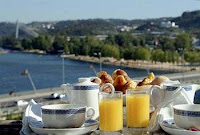1. Hotel Olissippo Lapa Palace (5 stars)
The gracious 5 star Olissippo Lapa Palace hotel is surrounded with beautiful gardens on the most prestigious of Lisbon's seven hills is a stately 19th century palace. The service found at this hotel is reminescent of a bygone era, while the updated facilities will meet the needs of the most demanding contemporary guest.
In summer you can enjoy a beautiful outdoor swimming pool and lavish sub tropical gardens. The spa is always a treat, with a heated indoor swimming pool, sauna, Turkish bath, fully equipped gym and some of the finest spa treatments available.
The magnificent grounds, luxury accommodation, excellent facilities, unrelenting
attention to detail, and superlative service at Lapa Palace earns this property a ranking among the best hotels in the world.
Price: Start at $258 dollars per night.
Address: Rua do Pau da Bandeira nº4
1249-021 Lisbon
Phone: (+351) 291 724 325
2. Hotel Avenida Palace (5 stars)
Set in a beautifully restored 19th Century building, the Hotel Avenida Palace is located in the Lisbon’s vibrant heart, making it the perfect home base from which to see this capital city. Speaking of sightseeing, this hotel gives you great views of the majestic Moorish Castelo São Jorge.
Combining this exceptional location between Lisbon’s Pombaline Downtown and the Avenida da Liberdade, an elegant neoclassical architecture, sophisticated and luxurious decoration and more than a century of history, Hotel Avena Palace creates a wonderful experience for the traveler.
Price: Start at $178 dollars per night.
Address: Rua 1. De Dezembro, 123, 1200-359 Lisbon
Phone: (+351) 213 218 115
 3. Hotel Solar Do Castelo (4 stars)
3. Hotel Solar Do Castelo (4 stars)
For the history buff, the Hotel Solar Do Castelo will take you back to the 18th century where the Hotel is built on the site of the former kitchens of the Alcáçovas Palace. The doors of the hotel open out onto a beautiful, uncluttered patio where the blue of the peacocks predominates the visual impact. Framed by the Lisbon Pombaline tile-work, the patio creates a serene refuge . Security and privacy are paramount at Solar Do Castelo where our grounds are exclusive for our guests.

The small unit comprising an attic, two living areas, and a patio and a garden also stores objects found during the renovation of a property with eight centuries of History.
Price: Start at $183 dollars per night
Address: Rua das Cozinhas 2 | (ao Castelo), Lisbon 1100-181, Portugal
Phone: (+351) 218 806 050
4. Suites Mercador (4 stars)

Suites Mercador provides an elegant, Rococo style ambiance with tiled floors, stuccoed walls, and intricate decor. This 16th century hotel is located in the heart of Lisbon and offers elegant rooms with modern kitchenettes.
All rooms feature lovely furnishings and plush beds with crisp, white linens. Some rooms feature ornate, wooden headboards and chandeliers.
The kitchenettes are well-equipped with a coffee maker, a refrigerator and silverware. A dining area and a sitting area with a sofa is offered in every room.
Price: Start at $ 143 dollars per night
Address: Rua De São José, 164, Coracao de Jesus, 1150-326 Lisbon
Phone: (+351) 912 269 865
4. SANA Executive Hotel (3 stars)
The Sana Executive Hotel is located in one of the new areas of Lisbon, within walking distance of many of the major visitor attractions. Close by the traveler can enjoy the charms of the world famous Calouste Gulbenkian Museum .
Located close to major business districts and only approximately 15 miles from Lisbon International Airport, the SANA is an ideal base for business travellers.
Price: Start at $72 dollars per night
Address: Avenida Conde de Valbom, 56, Lisbon, , 1050-069 Portugal
Phone: (+351)-217 951 157
6. Hotel HF Ipanema Park in Porto (4 stars)
If you are traveling to Porto, the Hotel Ipanema Park is an icon of tradition and luxury. A business, luxury hotel, it is renowned for its exceptional personalized service and attention to details. The hotel also boasts excellent security and state-of-the-art technology.
Strategically located between Boavista and Foz, just a few minutes from both the city center and the highway, the Hotel Ipanema Park provides access to the airport and the city of Lisbon.
Price: Starts at $ 67 dollars per night
Address: Rua De Serralves 124, Porto, 4150702 Portugal
Phone:(+351) -225 322 100
7. Hotel Astoria in Coimbra (3 stars)
With a prime location overlooking the Mondego River in the very heart of Coimbra’s historical city the Hotel Astória is a charming, classic hotel. Its stylish comfort, classic feel and refined European service have given it a reputation of quiet elegance for the refined guests.
Centrally positioned in this fine university city, Hotel Astória is easily within range of numerous top city attractions, such as the university - with it’s exclusive Baroque library, the fascinating Machado de Castro Museum and the ‘Baixa’ – a vibrant downtown area warren of cobbled, narrow streets full of cafés, shops and churches.
 Price:
Price: Starts at $ 67 dollars per night
Address: Avenida Emidio Navarro 21, Coimbra, 3000 Portugal
Phone: (+351)-239 853 020
 Religion
Religion Of note, the Reformation began in Zurich on January 1, 1519, when Father Ulrich Zwingli departed from church tradition by preaching a series of expository sermons from the Gospel of Matthew. In the weeks that followed, people crowded his church in Zurich to hear such revolutionary teaching.
Of note, the Reformation began in Zurich on January 1, 1519, when Father Ulrich Zwingli departed from church tradition by preaching a series of expository sermons from the Gospel of Matthew. In the weeks that followed, people crowded his church in Zurich to hear such revolutionary teaching.












































